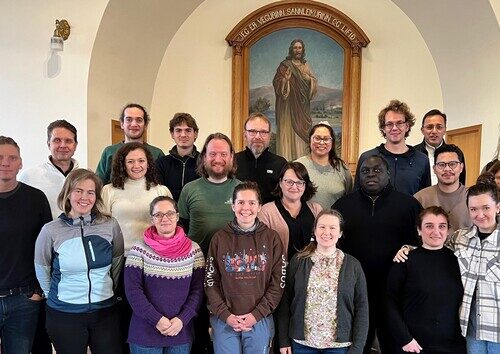03 September 2018 | Belgrade, Serbia [Gavin Anthony]
Who are we, and where are we going?
As aggressive secularism has nurtured a post-Christian culture in many of the countries of the Trans-European Division, this is a question that has never been more relevant. It was in this context that Elizabeth Talbot, Sabbath morning speaker for the European Pastors’ Council in Belgrade, Serbia, challenged the listening church leaders to feed the spiritually hungry people of Europe with the broken body of Jesus—holding out Jesus to people who may be questioning, “is there enough for me?”![Pastor Elizabeth Talbot [photo credit: Elsie Tjeransen/ADAMS] EPC18 Talbot2](https://ted.adventist.org/sitenews/wp-content/uploads/2018/09/images_news-2018_EPC18-Talbot2-scaled.jpg)
Focusing on Mark 6-8, Talbot explored the two different accounts of the loaves and the fishes. On the Jewish side of Lake Galilee, Jesus was given five loaves of bread which He took, blessed, broke, gave back the people. After the people had finished eating, twelve baskets of left-over bread were collected. Talbot suggested that the five loaves symbolised the five books of the Torah and the twelve baskets symbolic of the twelve tribes of Israel and that everyone left satisfied with plenty of food to spare.
Later on, Jesus went to the other side of the lake where the Gentiles lived. Here He was given seven loaves of bread which he also took, blessed, broke, gave back the people. Talbot suggested that the number seven was as significant to the Gentiles as the number twelve was to the Jews because seven was the number of nations that God ordered the Israelites to clear for the land. In other words, with the coming of Jesus, there was now bread for everyone—even for those outside the nation of Israel. But unfortunately, Jesus’ own disciples were slow in grasping this idea that Jesus was for everyone.
Talbot then compared these two feedings to Mark 14:22 where at the last supper, Jesus does the same four actions with the bread—where he takes it, blesses it, breaks it, and gives it back to His disciples. Jesus is the bread and can He can satisfy the hunger of any hungry soul. There is enough for everyone.
Talbot observed that the word translated basket used in the feeding of the 5000 and 4000 is different in the two accounts as the basket names reflected the two different cultures. Turning then to our own church, Talbot drew a parallel within our own church culture suggesting that we have 28 baskets, 28 important doctrines which can only feed hungry souls, but only if they are each filled with the bread of Jesus. If they are not filled with Jesus, they are empty baskets that will cause great hurt if they are simply thrown at people.
This idea of using empty baskets in our work struck a chord with Duco Kerssen, pastor from the Netherlands Union. He remarked, “What really touched me were the empty baskets—they need to be full with Christ. We need to stop playing church and start being church by sharing Christ as His disciples.” Eric Gudmundsson, who works in Iceland was struck by the same idea, “we tend to present empty baskets, and we need to remember that in everything we do we must present the suffering and service of Jesus.”
Elizabeth Talbot is the Speaker/Director for the Jesus 101 Biblical Institute, a media ministry of the North American Division of Seventh-day Adventists (www.jesus101.tv). Reflecting on her own motivation for this ministry, she declares that sharing the good news of Jesus Christ is “like fire in my bones.”
Her sermon therefore invited us all across Europe to share in this same fire—to urgently take the bread of Jesus to everyone, no matter whether they are “Jewish or Gentile, black or white, men or women”, because the bread of the person of Jesus can satisfy the spiritual hunger of everyone.
Reading from Gospel Works, Talbot emphasised the need to place Christ as the centre of everything:
“The sacrifice of Christ as an atonement for sin is the great truth around which all other truths cluster. In order to be rightly understood and appreciated, every truth in the word of God, from Genesis to Revelation, must be studied in the light that streams from the cross of Calvary. I present before you the great, grand monument of mercy and regeneration, salvation and redemption,—the Son of God uplifted on the cross. This is to be the foundation of every discourse given by our ministers.” (Ellen White, Gospel Workers, 315)
But as Talbot observed, we don’t do this work because we are better people, but because we are lepers who had been satisfied with broken bread and want to pass it on.
“Go out with the baskets but make sure they are full with the broken body of Jesus.”
tedNEWS Staff: Victor Hulbert, editor; Sajitha Forde-Ralph, associate editor
119 St Peter’s Street, St Albans, Herts, AL1 3EY, England
E-mail: [email protected]
Website: www.ted.adventist.org
tedNEWS is an information bulletin issued by the communication department of the Seventh-day Adventist Church in the Trans-European Division. Readers are free to republish or share this article with appropriate credit including an active hyperlink to the original article.



